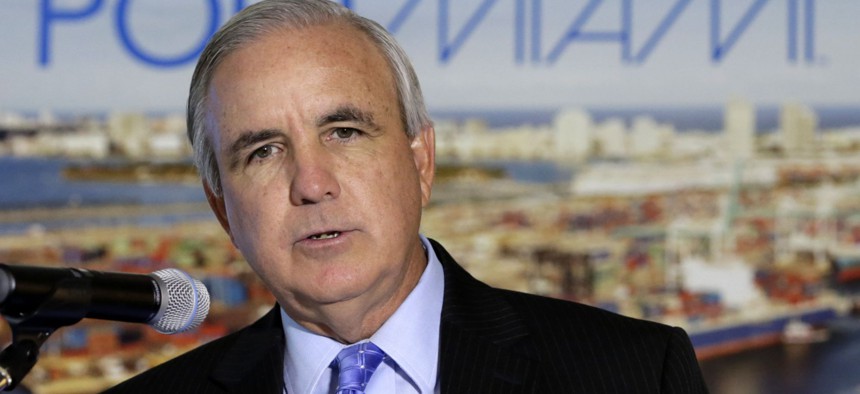Miami-Area Mayors vs. Florida Dept. of Health; Montana’s Fish Kill Economic Impacts

Miami-Dade County Mayor Carlos Gimenez Alan Diaz / AP File Photo
Also in our State and Local Weekend News Digest: A Google Maps vanishing act; a stinky reservoir in Columbus, Ohio; expensive suicide nets for Golden Gate Bridge.
MIAMI, FLORIDA
ZIKA | After the Florida Department of Health last week said that it never told local officials that they were forbidden from disclosing the locations of traps where mosquitoes carrying the Zika virus were discovered, the mayors of Miami-Dade County and Miami Beach accused the state agency of lying. “During multiple meetings, phone calls and conversations, officials from the Florida Department of Health explicitly stated to county officials that information identifying the addresses of traps containing mosquitoes positive for the Zika virus is confidential during active, ongoing epidemiological investigations,” Miami-Dade Mayor Carlos Gimenez said in a statement. “Mayor Gimenez is only doing what the state told him, his staff, me and my entire staff, specifically, that they would not permit the county to release the information on the locations,” Miami Beach Mayor Philip Levine said Sunday. [Miami Herald]
PARK COUNTY, MONTANA
ECONOMIC DEVELOPMENT | The economic losses from the state closing 183 miles of the Yellowstone River due to a parasite outbreak that led to a widespread fish kill are beginning to add up. According to the University of Montana’s Institute for Tourism and Recreation, the total amount of losses in Park County, where 31 percent of jobs are tied to tourism, ranges from $360,000 to $524,000, or about five to eight full-time positions. An official with the local chamber of commerce said that it is likely the impacts of the river’s closure are much higher than the report found. [Bozeman Daily Chronicle]
MOUNTAIN VIEW, CALIFORNIA
GREEN SPACES | State parks and national forests are among the green spaces that have pulled a vanishing act on Google Maps, being greyed out. You can still search for the Blue Hills Reservation in Massachusetts, but you might miss it simply navigating the area on Google Maps. "I've seen minor discrepancies between their data and ours, but never an entire forest,” said Donavan Albert, who runs the U.S. Forest Service’s locater map. Most of New York’s public lands are state-owned and have seen patchwork disappearances on the app. Apple Maps hasn’t proven much more accurate. Google is encouraging users to “Report a Problem” via the link at the bottom right corner of its maps. [National Public Radio]
PHILADELPHIA, PENNSYLVANIA
PUBLIC TRANSIT | Summer hasn’t been kind to the Southeastern Pennsylvania Transportation Authority, which has seen a decrease in ridership and revenue since finding safety issues with its rail cars Fourth of July weekend. A total of 120 Silverliner cars with suspension problems were pulled from service, and rail schedules had to be consolidated—meaning slower service. “July’s ridership was down nearly 21 percent and then in August it was slightly better but we were still down 10 percent,” said spokesman Andrew Busch. That’s equal to about $7 million in lost revenue. Fares won’t be hiked to cover the difference, though a pre-planned increase in July is still on schedule. [CBS Philly]
COLUMBUS, OHIO
SMELLS | Stinky odors from a reservoir that provides water to the Columbus metro region have prompted complaints. Officials say water from the Hoover Reservoir is safe to drink. They blame a long and hot summer and bacteria in colder water at the bottom of the reservoir for the unpleasant aroma, which some have described as “earthy.” In an effort to keep the smell from getting worse, there are plans to open the lowest gate on the reservoir’s dam to flush away bacteria-laden cold water. “It definitely is not good,” said one man who regularly runs near the reservoir. “I feel for those that live across the street.” [The Columbus Dispatch]
SAN FRANCISCO, CALIFORNIA
INFRASTRUCTURE | Bids to construct suicide nets on the Golden Gate Bridge have come in at about double the originally estimated cost. Contractors for the Golden Gate Bridge Highway and Transportation District had pegged the price tag for the net at $75.6 million. The bids that came in were $174 million and $142 million. A district committee voted last week to extend the bidding period by 90 days, so officials could examine why the bids are so high. Denis Mulligan, the district’s general manager said access is likely one factor. Plans call for the net to be built 20 feet below the bridge’s sidewalk, complicating “how to get the parts there.” [San Francisco Examiner]





